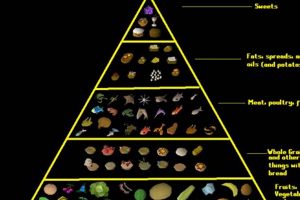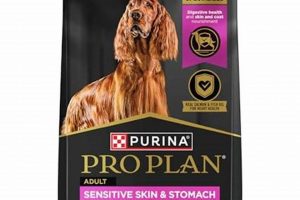Selecting the appropriate nutritional source for a giant breed canine is paramount to ensure optimal health and well-being. This is especially true during puppyhood, where proper growth is crucial to minimize the risk of developmental orthopedic diseases. The dietary needs of a St. Bernard must be met with carefully formulated provisions designed to support their large frame and specific metabolic requirements.
Providing a diet specifically tailored to this breed offers numerous advantages, including controlled growth rates, which reduce stress on developing joints. Furthermore, appropriate nutrition can aid in maintaining a healthy weight, a critical factor in preventing obesity-related health problems common in large dogs. Historically, these dogs were working animals requiring substantial caloric intake, but modern sedentary lifestyles necessitate a more balanced nutritional approach.
The subsequent sections will explore key considerations in choosing a suitable diet, encompassing optimal protein and fat levels, the significance of glucosamine and chondroitin, and practical feeding guidelines to ensure a long and healthy life for this magnificent breed.
Dietary Guidance for Optimal St. Bernard Health
The following recommendations offer insights into selecting and administering nutrition to maximize the well-being of a St. Bernard. Considerations encompass developmental stages, activity levels, and potential breed-specific health concerns.
Tip 1: Prioritize Breed-Specific Formulations: Selecting provisions explicitly designed for giant breeds is crucial. Such formulations typically contain controlled calcium and phosphorus levels to support healthy bone development and mitigate the risk of skeletal disorders such as hip dysplasia.
Tip 2: Monitor Growth Rates: Rapid growth can predispose large breed puppies to orthopedic problems. Adhere to feeding guidelines provided by the manufacturer and adjust portions as needed to maintain a healthy body condition. Regular veterinary checkups are essential to monitor growth trajectory.
Tip 3: Scrutinize Protein Content: Ensure an adequate, but not excessive, protein level. While protein is essential for muscle development and maintenance, excessive intake can contribute to accelerated growth and potential skeletal issues. Consult with a veterinarian to determine the appropriate protein percentage for the dog’s life stage and activity level.
Tip 4: Incorporate Joint Support Supplements: Glucosamine and chondroitin are beneficial for joint health. Including a provision that contains these supplements, or administering them separately, may help mitigate the risk of osteoarthritis and support joint function, particularly in older individuals or those with a predisposition to joint problems.
Tip 5: Regulate Caloric Intake: Obesity is a significant health concern in St. Bernards. Carefully manage caloric intake, taking into account activity levels and individual metabolic rates. Avoid overfeeding and limit treats to prevent weight gain.
Tip 6: Divide Daily Rations: Feeding multiple smaller meals throughout the day, rather than one large meal, can reduce the risk of gastric dilatation-volvulus (GDV), also known as bloat, a life-threatening condition common in deep-chested breeds.
Tip 7: Observe Stool Quality: Changes in stool consistency can indicate dietary intolerance or digestive issues. Monitor stool quality regularly and consult a veterinarian if any persistent abnormalities are observed. Gradual dietary transitions are essential to minimize gastrointestinal upset.
Adhering to these guidelines can significantly contribute to the long-term health and well-being of a St. Bernard, minimizing the risk of common breed-specific health issues and ensuring a higher quality of life.
The following section will delve into specific provision recommendations, considering various life stages and dietary needs.
1. Giant Breed Formula
The selection of provisions labeled as “Giant Breed Formula” is intrinsically linked to the suitability of nutrition for a St. Bernard. These formulations are specifically engineered to address the unique physiological needs associated with rapid growth and substantial adult size, making them a critical consideration in determining the optimal nutritional source for this breed.
- Controlled Calcium and Phosphorus Levels
Giant breed formulas contain precise ratios of calcium and phosphorus, essential minerals for bone development. Excess or imbalance can lead to developmental orthopedic diseases like hip and elbow dysplasia. The levels are carefully calibrated to promote healthy bone growth without overwhelming the skeletal system.
- Moderate Calorie Density
These provisions are formulated with a moderate calorie density to prevent excessively rapid growth. Rapid weight gain can place undue stress on developing joints, increasing the risk of orthopedic problems. Controlling calorie intake is crucial for fostering a healthy growth trajectory.
- Adequate, But Not Excessive, Protein Content
Giant breed formulas typically contain adequate levels of high-quality protein to support muscle development and tissue repair. However, protein levels are carefully controlled to avoid excessive growth, which can also contribute to skeletal issues. The emphasis is on sustained, healthy development rather than rapid mass gain.
- Glucosamine and Chondroitin Sulfate Supplementation
Many giant breed formulas include glucosamine and chondroitin sulfate to support joint health. These supplements help protect cartilage and reduce inflammation, mitigating the risk of osteoarthritis, a common concern in large and giant breeds. This preventative approach is vital for maintaining mobility and quality of life.
The careful balance of nutrients within a giant breed formula directly addresses the specific challenges associated with raising a St. Bernard, making it an essential component in achieving the overarching goal of providing optimal nutrition and supporting long-term health for this breed. The use of these tailored provisions demonstrates a proactive approach to managing potential health risks and promoting well-being.
2. Controlled Growth Rate
Controlled growth rate is a critical factor in determining the suitability of nutrition for a St. Bernard. Rapid, unrestrained growth, often associated with excessive caloric or nutrient intake, can predispose these dogs to a range of developmental orthopedic diseases. These diseases, including hip dysplasia, elbow dysplasia, and osteochondrosis dissecans (OCD), can significantly impact mobility and quality of life. A provision that promotes a steady, moderate growth trajectory is, therefore, a cornerstone of appropriate nutrition for this breed. The provision enables skeletal development to occur in harmony with muscle mass, mitigating stress on developing joints.
Practical application of this principle involves careful monitoring of caloric intake and weight gain. Adherence to manufacturer feeding guidelines is necessary, but these guidelines serve as a starting point. Adjustments based on individual metabolic rates, activity levels, and body condition are essential. Regular veterinary checkups, including weight monitoring and musculoskeletal assessments, aid in identifying potential issues early. For instance, a St. Bernard puppy gaining weight excessively quickly might require a reduction in daily rations or a switch to a provision with a lower calorie density. Conversely, an underweight puppy might need increased caloric intake. The focus remains on achieving a balanced and sustainable growth pattern.
In summary, the connection between controlled growth rate and provision choice for St. Bernards is undeniable. By prioritizing provisions that support steady development, observing appropriate feeding practices, and maintaining consistent veterinary oversight, owners can significantly reduce the risk of debilitating orthopedic conditions and promote a long and healthy life for their canine companions. The challenge lies in the proactive management of nutritional factors to ensure the dog’s well-being.
3. Joint Support Additives
The inclusion of joint support additives in canine provisions, particularly those formulated for large and giant breeds like the St. Bernard, constitutes a proactive strategy to mitigate the risk of degenerative joint conditions. These additives, primarily glucosamine and chondroitin sulfate, play a critical role in maintaining cartilage integrity and reducing inflammation within the joints, contributing significantly to the overall suitability of a provision.
- Glucosamine’s Role in Cartilage Synthesis
Glucosamine serves as a precursor in the synthesis of glycosaminoglycans, essential components of cartilage. By providing a readily available source of glucosamine, these additives support the body’s natural ability to repair and maintain cartilage, thereby cushioning the joints and reducing friction during movement. Real-world examples include improved mobility and reduced stiffness in St. Bernards predisposed to osteoarthritis. The implications for provision selection are clear: formulations containing glucosamine offer a preventative benefit against joint degradation.
- Chondroitin Sulfate’s Anti-Inflammatory Properties
Chondroitin sulfate possesses anti-inflammatory properties that can help reduce pain and swelling in affected joints. It inhibits enzymes that break down cartilage and promotes water retention, further contributing to joint lubrication and shock absorption. In the context of St. Bernards, this can translate to a reduced need for pain medication and improved long-term joint health. The presence of chondroitin sulfate enhances the provision’s therapeutic value in combating age-related joint issues.
- Synergistic Effects of Glucosamine and Chondroitin
While both glucosamine and chondroitin offer individual benefits, their combined use often yields synergistic effects. Research suggests that the combination of these additives is more effective than either compound alone in reducing pain and improving joint function. In provisions designed for St. Bernards, the inclusion of both components represents a comprehensive approach to joint health management, maximizing the potential for positive outcomes.
- Sources and Bioavailability of Joint Support Additives
The effectiveness of joint support additives is also dependent on their source and bioavailability. Certain forms of glucosamine and chondroitin are more readily absorbed and utilized by the body than others. Look for provisions that specify the source of these additives and prioritize those with evidence of high bioavailability. This consideration ensures that the additives are effectively delivered to the joints, maximizing their potential therapeutic benefits.
In summary, the inclusion of joint support additives is a crucial element in provisions designed for St. Bernards, offering a proactive approach to preserving joint health and mitigating the risk of degenerative joint conditions. By understanding the roles of glucosamine and chondroitin, their synergistic effects, and the importance of bioavailability, owners can make informed decisions when selecting the best nutrition for their canine companions. A focus on these factors contributes significantly to the provision’s suitability and its potential to improve the long-term quality of life for this breed.
4. Appropriate Protein Levels
The level of protein within a St. Bernard’s nutritional intake significantly influences various physiological processes, from muscle development and maintenance to immune function. The selection of provisions with “Appropriate Protein Levels” is, therefore, an essential consideration when determining the ideal diet for this giant breed, directly impacting its overall health and well-being.
- Muscle Development and Maintenance
Protein serves as the fundamental building block for muscle tissue. Adequate protein intake is crucial for supporting muscle growth during puppyhood and maintaining muscle mass throughout adulthood. However, excessive protein levels can contribute to accelerated growth rates, potentially exacerbating the risk of orthopedic problems. The “Appropriate Protein Levels” strike a balance, providing sufficient protein for muscle development without promoting excessively rapid growth that stresses the skeletal system. For example, a working St. Bernard may require a slightly higher protein percentage compared to a sedentary companion animal.
- Skeletal Health Considerations
While protein is essential, excessive consumption can negatively impact skeletal health, particularly during the rapid growth phase. High-protein diets have been linked to increased calcium excretion and may disrupt the delicate balance of mineral metabolism necessary for proper bone development. “Appropriate Protein Levels” consider this relationship, ensuring that the provision supports healthy bone growth without predisposing the animal to skeletal disorders. This balance is often achieved through precise ratios of protein, calcium, and phosphorus within the nutritional formulation.
- Kidney Function and Protein Metabolism
The kidneys play a crucial role in filtering waste products generated during protein metabolism. While healthy dogs can typically tolerate moderate to high protein levels, individuals with pre-existing kidney issues may require provisions with reduced protein content to minimize stress on their renal system. “Appropriate Protein Levels” for a St. Bernard with compromised kidney function would differ significantly from those for a healthy, active dog. Regular veterinary checkups and bloodwork are essential to assess kidney function and tailor protein intake accordingly.
- Protein Sources and Digestibility
The source and digestibility of protein are as important as the overall percentage. High-quality protein sources, such as animal-derived proteins, are generally more digestible and provide a more complete amino acid profile compared to plant-based proteins. “Appropriate Protein Levels” are achieved through the inclusion of readily digestible protein sources that the St. Bernard’s digestive system can efficiently process. This ensures that the animal receives the necessary amino acids for optimal health without experiencing digestive upset or nutritional deficiencies.
The facets discussed collectively emphasize that “Appropriate Protein Levels” are not simply a matter of feeding a high or low-protein diet. Rather, they represent a nuanced consideration of the St. Bernard’s age, activity level, health status, and the quality of the protein source. Selecting a provision that carefully balances these factors is vital for promoting optimal muscle development, skeletal health, and overall well-being in this magnificent breed.
5. Calorie Density Management
Calorie density management is a critical aspect of selecting appropriate nutrition for a St. Bernard. This term refers to the concentration of calories per unit of volume, typically expressed as calories per cup or kilogram of provision. Controlling calorie density is paramount for maintaining a healthy weight and preventing obesity, a prevalent health concern in this breed. Uncontrolled caloric intake can lead to excessive weight gain, placing undue stress on joints and increasing the risk of orthopedic diseases, cardiovascular issues, and decreased lifespan. Therefore, selecting provisions with carefully managed calorie density directly aligns with the goals of identifying optimal nutrition for a St. Bernard.
The practical application of calorie density management involves several key considerations. First, accurately assessing the St. Bernard’s daily caloric needs is essential, accounting for factors such as age, activity level, and metabolic rate. Highly active St. Bernards will require a greater caloric intake than sedentary companions. Second, diligently reading provision labels and comparing calorie densities across different options is necessary. Third, carefully measuring portion sizes and adhering to feeding guidelines provided by the manufacturer is crucial. However, these guidelines should be adjusted based on the individual dog’s body condition and weight fluctuations. Regular veterinary checkups and body condition scoring can help determine if the current caloric intake is appropriate. For instance, if a St. Bernard is gaining weight despite following the recommended feeding guidelines, reducing portion sizes or switching to a provision with a lower calorie density may be necessary. Conversely, if a St. Bernard is underweight, increasing portion sizes or selecting a provision with a higher calorie density may be warranted.
In summary, calorie density management is an indispensable component of optimal nutrition for St. Bernards. The careful selection of provisions with appropriate calorie densities, combined with meticulous monitoring of weight and body condition, can significantly reduce the risk of obesity-related health problems and promote a long and healthy life. Addressing the specific caloric needs of this breed requires a proactive approach and a thorough understanding of the relationship between calorie density, portion sizes, and overall health. This understanding enables owners to make informed decisions about their dog’s diet and contribute to its well-being.
6. Digestive Health Focus
A focus on digestive well-being is paramount when selecting appropriate nutrition for a St. Bernard. This breed’s large size and deep chest predispose it to gastric dilatation-volvulus (GDV), commonly known as bloat, a life-threatening condition where the stomach fills with gas and twists. Furthermore, their significant appetite coupled with a sensitive digestive system can lead to other gastrointestinal disturbances such as diarrhea, flatulence, and vomiting. Therefore, prioritizing a provision that emphasizes digestive health is a crucial component in identifying what constitutes optimal nourishment for this specific breed. The formulation of provisions designed with a digestive health focus often includes carefully selected ingredients that promote efficient digestion, minimize gas production, and support a healthy gut microbiome. This focus directly mitigates the risks associated with bloat and other digestive issues common in St. Bernards.
Provisions exhibiting a digestive health focus often incorporate several key features. These include highly digestible protein sources, moderate fiber content, and the inclusion of prebiotics and probiotics. Highly digestible protein minimizes the amount of undigested matter reaching the colon, thus reducing the production of fermentation gases. Moderate fiber content aids in maintaining regular bowel movements and preventing both constipation and diarrhea. Prebiotics, such as fructooligosaccharides (FOS) and mannanoligosaccharides (MOS), nourish beneficial gut bacteria, while probiotics introduce live microorganisms to the digestive tract, promoting a balanced gut microbiome. A balanced gut microbiome is associated with improved nutrient absorption, enhanced immune function, and reduced susceptibility to digestive upset. An example is using a high-quality lamb or salmon provision versus one laden with difficult-to-digest corn and wheat products.
In conclusion, the connection between a digestive health focus and the selection of provisions for St. Bernards is firmly established. By prioritizing provisions that incorporate easily digestible ingredients, moderate fiber levels, and pre/probiotic supplementation, owners can significantly reduce the risk of bloat, improve digestive function, and enhance overall health. The challenge lies in discerning the nutritional profile most suitable for an individual animal, often requiring careful monitoring of stool quality, appetite, and overall well-being, coupled with ongoing consultation with a veterinarian to fine-tune dietary choices. This emphasis on digestive health constitutes a fundamental element in the holistic approach to providing optimal nutrition for this breed.
Frequently Asked Questions
The following addresses common inquiries regarding the dietary requirements of St. Bernards. The subsequent answers provide essential information to ensure the well-being of this breed.
Question 1: What specific dietary considerations are necessary for St. Bernard puppies?
St. Bernard puppies necessitate provisions formulated for giant breeds. These formulations typically feature controlled calcium and phosphorus levels to promote optimal bone development and mitigate the risk of orthopedic diseases. Rapid growth should be avoided through careful monitoring of caloric intake.
Question 2: Is a grain-free provision preferable for St. Bernards?
Grain-free provisions are not inherently superior for St. Bernards. The decision to feed a grain-free diet should be based on individual sensitivities or allergies, diagnosed by a veterinarian. Grains can provide valuable nutrients and fiber; however, some individuals may exhibit adverse reactions.
Question 3: How much provision should a St. Bernard be fed daily?
The amount of provision administered daily varies depending on age, activity level, and metabolic rate. Manufacturer feeding guidelines serve as a starting point, but adjustments may be necessary to maintain a healthy body condition. Regular monitoring of weight and body condition is crucial to fine-tune portion sizes.
Question 4: Are supplements necessary for St. Bernards on a balanced diet?
While a high-quality provision should provide the necessary nutrients, supplementation may be beneficial in certain cases. Glucosamine and chondroitin are commonly recommended to support joint health, particularly in older individuals or those with a predisposition to arthritis. Consult a veterinarian before administering any supplements.
Question 5: How can gastric dilatation-volvulus (GDV) be prevented through dietary management?
Preventative measures include feeding multiple smaller meals throughout the day, avoiding vigorous exercise immediately before or after feeding, and elevating the food bowl. Selecting a provision with a smaller kibble size may also reduce the risk of GDV.
Question 6: What signs indicate a St. Bernard is not tolerating its current provision?
Signs of intolerance may include digestive upset (diarrhea, vomiting, flatulence), skin irritation, excessive scratching, or changes in appetite. If these signs are observed, consult a veterinarian to rule out underlying medical conditions and discuss potential dietary adjustments.
In summary, adherence to these guidelines and consistent monitoring of the dog’s health status are essential for ensuring optimal nutrition and well-being. The consultation of a veterinary professional is highly recommended for personalized dietary recommendations.
The following section will delve into the future trends in provision formulation and personalized canine nutrition.
Best Dog Food for St. Bernard
The preceding exploration has illuminated the pivotal factors in selecting the best dog food for St. Bernard, emphasizing the breed’s unique nutritional requirements. Giant breed formulations, controlled growth rates, joint support additives, appropriate protein levels, calorie density management, and a digestive health focus represent the cornerstones of a suitable dietary regimen. Prioritizing these elements is vital for mitigating the risk of orthopedic diseases, managing weight, and promoting optimal digestive function.
Ultimately, the responsible ownership of a St. Bernard necessitates a proactive and informed approach to nutrition. Diligent monitoring of the animal’s health, coupled with ongoing consultation with veterinary professionals, is essential for tailoring dietary choices to individual needs. This dedication will contribute to a longer, healthier, and more fulfilling life for this magnificent breed.







